Abstract
The mechanism of the clastogenic action--i.e., the ability to induce chromosomal aberrations--of the tumor promoter phorbol 12-myristate 13-acetate (PMA) was investigated. PMA at 10 and 100 ng/ml induced the formation of a low molecular weight (less than 10,000) clastogenic factor (CF) in phytohemagglutinin-stimulated human blood and lymphocyte cultures. Bovine erythrocyte Cu-Zn superoxide dismutase strongly inhibited PMA clastogenicity, both the formation of CF and the action of previously formed CF. The nonsteroidal anti-inflammatory agents indomethacin, imidazol, and 5,8,11,14-icosatetraynoic acid inhibited PMA clastogenicity and the clastogenic activity of previously formed CF. These results suggest that superoxide radicals and stimulation of the arachidonic acid cascade play a role in PMA-induced clastogenicity and the mechanism of action of the CF. The CF may relate the initial interaction of PMA with the cell membrane to the genome.
Full text
PDF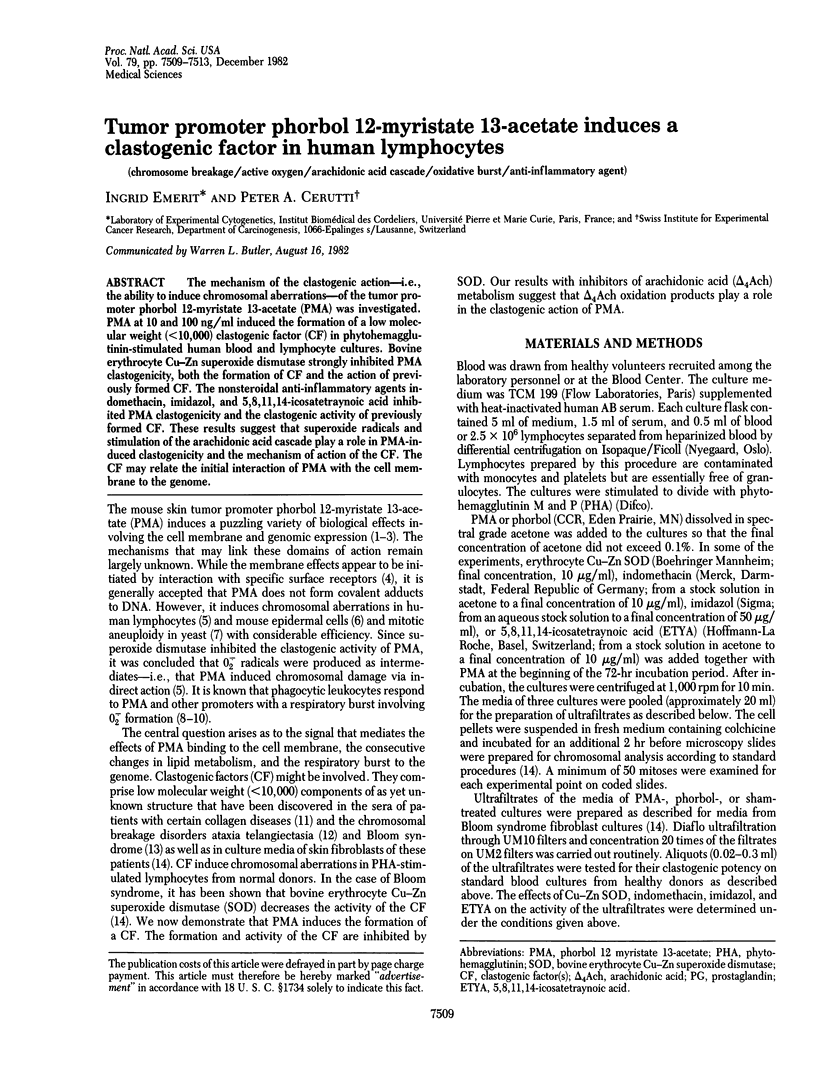
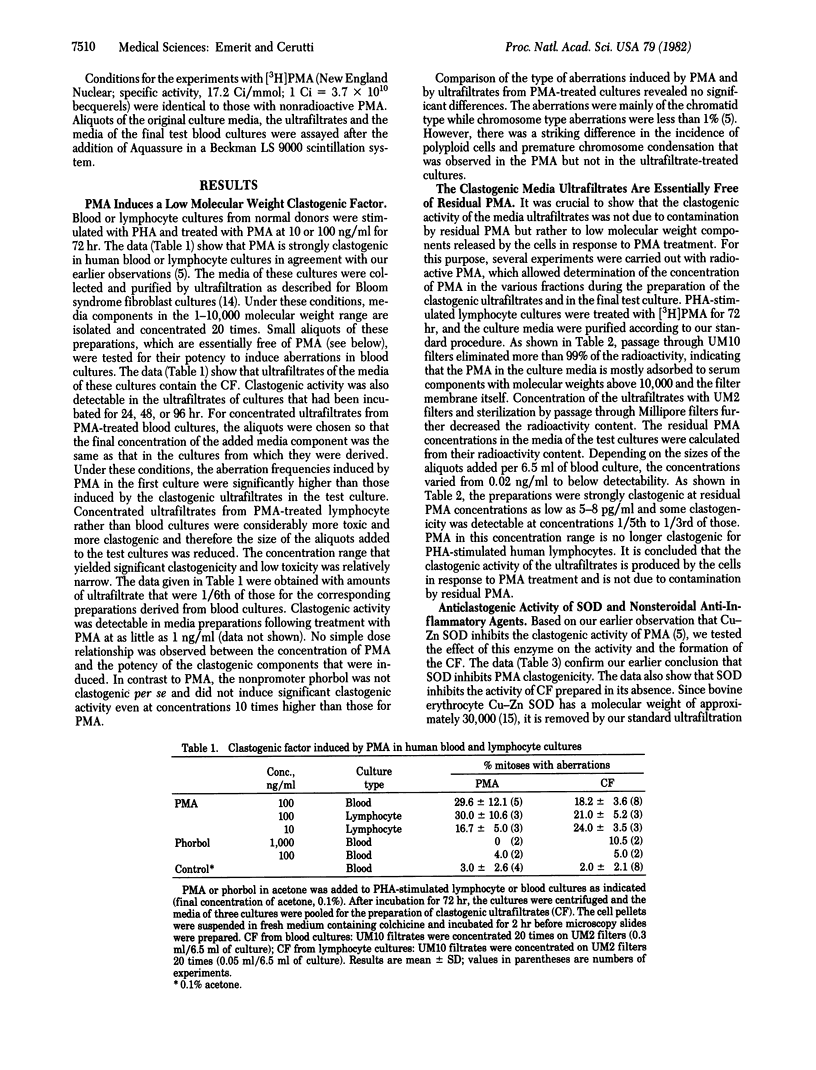
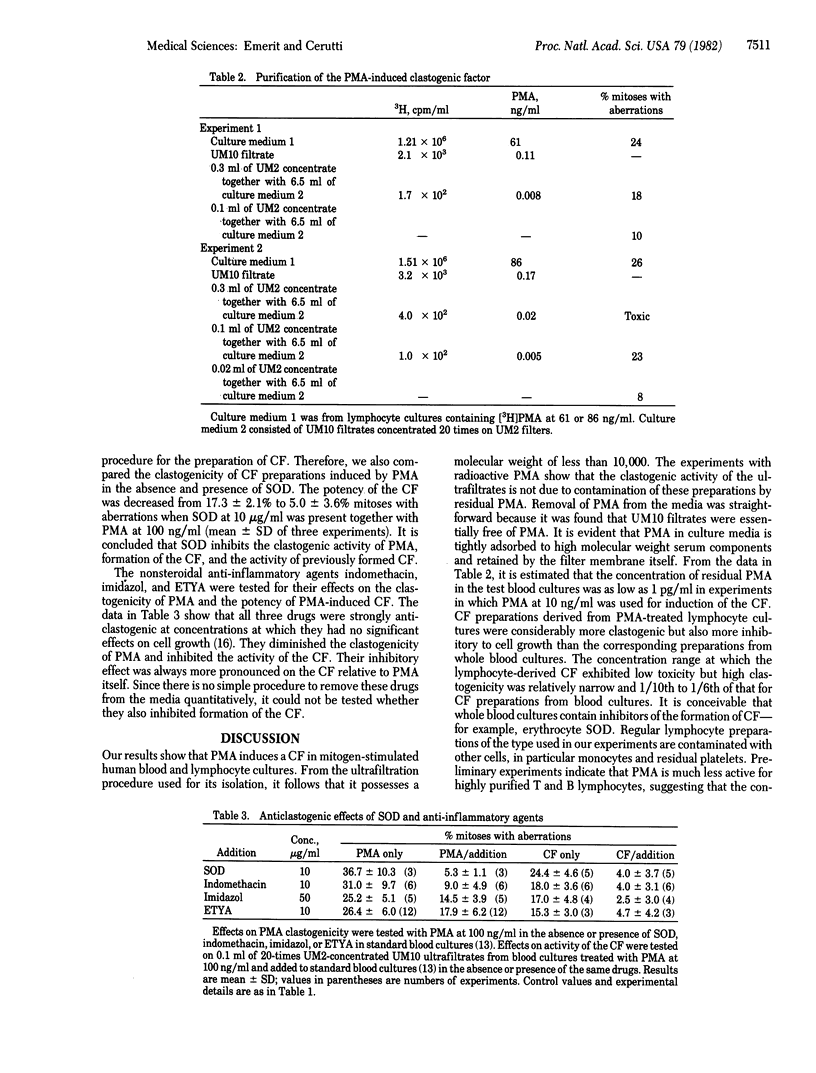
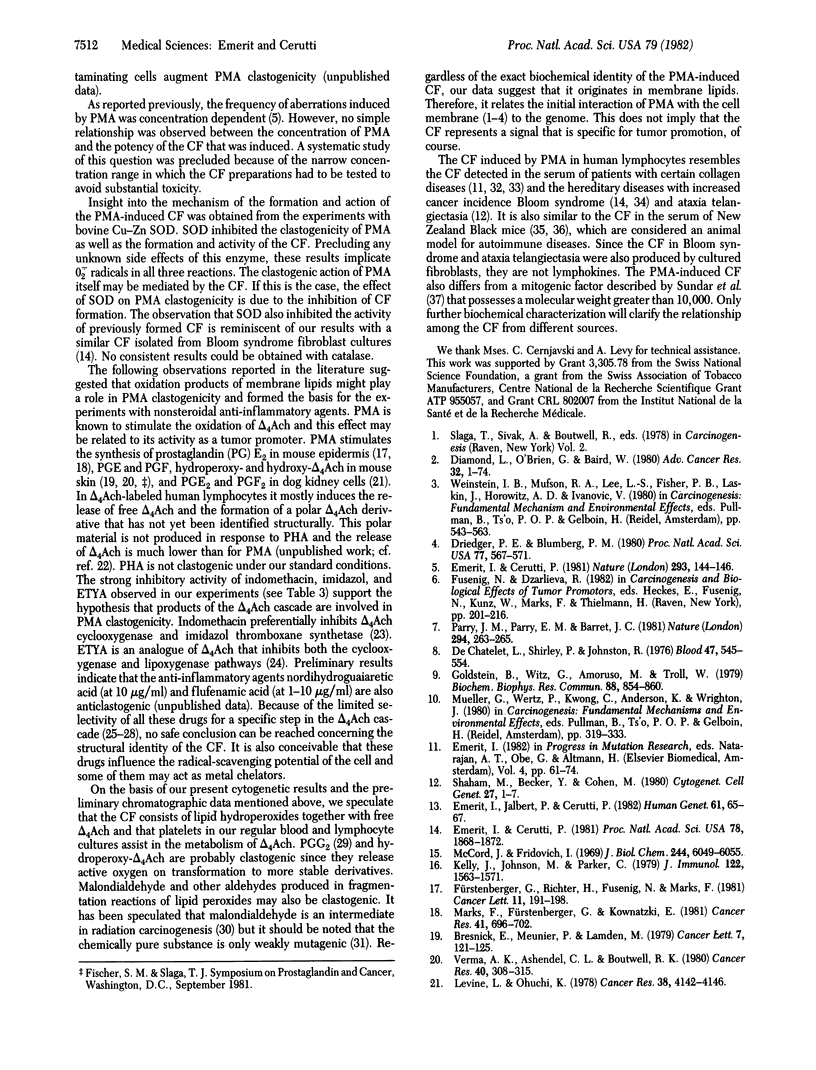
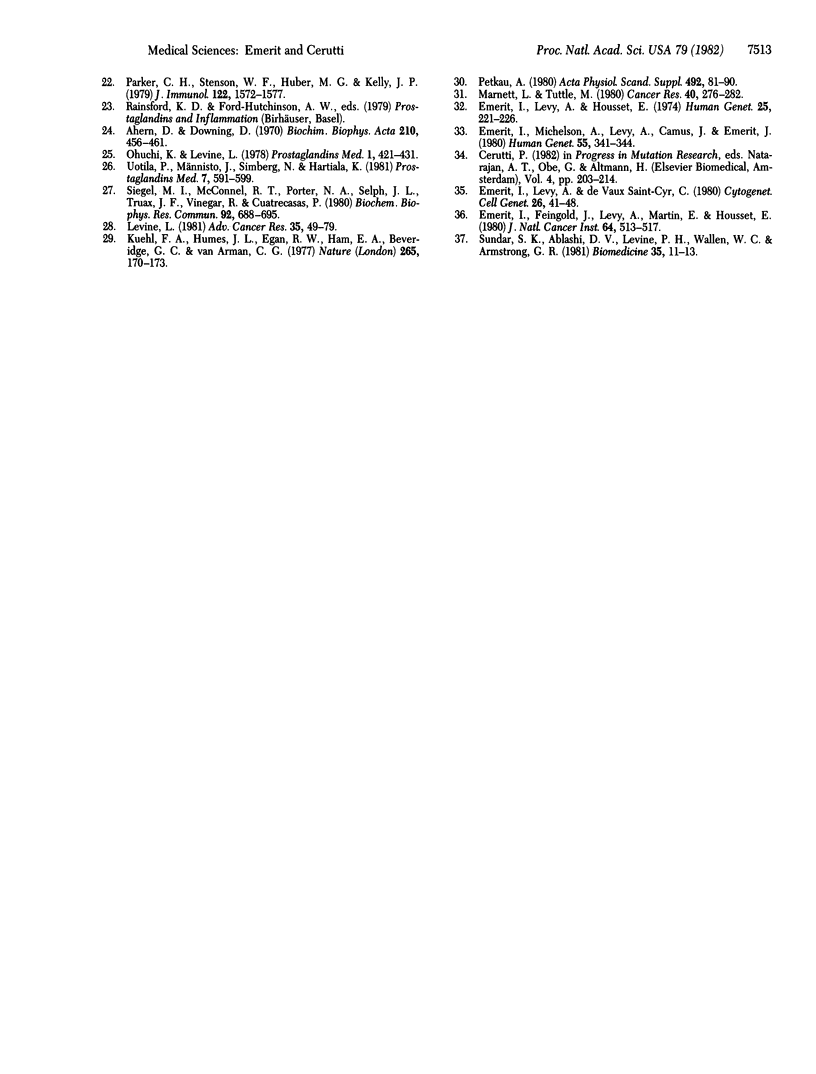
Selected References
These references are in PubMed. This may not be the complete list of references from this article.
- Ahern D. G., Downing D. T. Inhibition of prostaglandin biosynthesis by eicosa-5,8,11,14-tetraynoic acid. Biochim Biophys Acta. 1970 Sep 8;210(3):456–461. doi: 10.1016/0005-2760(70)90042-1. [DOI] [PubMed] [Google Scholar]
- Bresnick E., Meunier P., Lamden M. Epidermal prostaglandins after topical application of a tumor promotor. Cancer Lett. 1979 Jul;7(2-3):121–125. doi: 10.1016/s0304-3835(79)80106-8. [DOI] [PubMed] [Google Scholar]
- DeChatelet L. R., Shirley P. S., Johnston R. B., Jr Effect of phorbol myristate acetate on the oxidative metabolism of human polymorphonuclear leukocytes. Blood. 1976 Apr;47(4):545–554. [PubMed] [Google Scholar]
- Diamond L., O'Brien T. G., Baird W. M. Tumor promoters and the mechanism of tumor promotion. Adv Cancer Res. 1980;32:1–74. doi: 10.1016/s0065-230x(08)60360-7. [DOI] [PubMed] [Google Scholar]
- Driedger P. E., Blumberg P. M. Specific binding of phorbol ester tumor promoters. Proc Natl Acad Sci U S A. 1980 Jan;77(1):567–571. doi: 10.1073/pnas.77.1.567. [DOI] [PMC free article] [PubMed] [Google Scholar]
- Emerit I., Cerutti P. A., Levy A., Jalbert P. Chromosome breakage factor in the plasma of two Bloom's syndrome patients. Hum Genet. 1982;61(1):65–67. doi: 10.1007/BF00291336. [DOI] [PubMed] [Google Scholar]
- Emerit I., Cerutti P. A. Tumour promoter phorbol-12-myristate-13-acetate induces chromosomal damage via indirect action. Nature. 1981 Sep 10;293(5828):144–146. doi: 10.1038/293144a0. [DOI] [PubMed] [Google Scholar]
- Emerit I., Cerutti P. Clastogenic activity from Bloom syndrome fibroblast cultures. Proc Natl Acad Sci U S A. 1981 Mar;78(3):1868–1872. doi: 10.1073/pnas.78.3.1868. [DOI] [PMC free article] [PubMed] [Google Scholar]
- Emerit I., Feingold J., Levy A., Martin E., Housset E. Tumor incidence and development of autoimmune hemolytic anemia in two breeding lines of the NZB mouse strain that differ in chromosome breakage. J Natl Cancer Inst. 1980 Mar;64(3):513–517. [PubMed] [Google Scholar]
- Emerit I., Levy A., Housset E. Breakage factor in systemic sclerosis and protector effect of L-cysteine. Humangenetik. 1974;25(3):221–226. doi: 10.1007/BF00281430. [DOI] [PubMed] [Google Scholar]
- Emerit I., Levy A., de Vaux Saint Cyr C. Chromosome damaging agent of low molecular weight in the serum of New Zealand black mice. Cytogenet Cell Genet. 1980;26(1):41–48. doi: 10.1159/000131420. [DOI] [PubMed] [Google Scholar]
- Fürstenberger G., Richter H., Fusenig N. E., Marks F. Arachidonic acid and prostaglandin E2 release and enhanced cell proliferation induced by the phorbol ester TPA in a murine epidermal cell line. Cancer Lett. 1981 Jan;11(3):191–198. doi: 10.1016/0304-3835(81)90107-5. [DOI] [PubMed] [Google Scholar]
- Goldstein B. D., Witz G., Amoruso M., Troll W. Protease inhibitors antagonize the activation of polymorphonuclear leukocyte oxygen consumption. Biochem Biophys Res Commun. 1979 Jun 13;88(3):854–860. doi: 10.1016/0006-291x(79)91487-6. [DOI] [PubMed] [Google Scholar]
- Kelly J. P., Johnson M. C., Parker C. W. Effect of inhibitors of arachidonic acid metabolism on mitogenesis in human lymphocytes: possible role of thromboxanes and products of the lipoxygenase pathway. J Immunol. 1979 Apr;122(4):1563–1571. [PubMed] [Google Scholar]
- Kuehl F. A., Jr, Humes J. L., Egan R. W., Ham E. A., Beveridge G. C., Van Arman C. G. Role of prostaglandin endoperoxide PGG2 in inflammatory processes. Nature. 1977 Jan 13;265(5590):170–173. doi: 10.1038/265170a0. [DOI] [PubMed] [Google Scholar]
- Levine L. Arachidonic acid transformation and tumor production. Adv Cancer Res. 1981;35:49–79. doi: 10.1016/s0065-230x(08)60908-2. [DOI] [PubMed] [Google Scholar]
- Levine L., Ohuchi K. Stimulation by carcinogens and promoters of prostaglandin production by dog kidney (MDCK) cells in culture. Cancer Res. 1978 Nov;38(11 Pt 2):4142–4146. [PubMed] [Google Scholar]
- Marks F., Fürstenberger G., Kownatzki E. Prostaglandin E-mediated mitogenic stimulation of mouse epidermis in vivo by divalent cation ionophore A 23187 and by tumor promoter 12-O-tetradecanoylphorbol-13-acetate. Cancer Res. 1981 Feb;41(2):696–702. [PubMed] [Google Scholar]
- Marnett L. J., Tuttle M. A. Comparison of the mutagenicities of malondialdehyde and the side products formed during its chemical synthesis. Cancer Res. 1980 Feb;40(2):276–282. [PubMed] [Google Scholar]
- McCord J. M., Fridovich I. Superoxide dismutase. An enzymic function for erythrocuprein (hemocuprein). J Biol Chem. 1969 Nov 25;244(22):6049–6055. [PubMed] [Google Scholar]
- Ohuchi K., Levine L. Tumor promoting phorbol diesters stimulate release of radioactivity from [3H]-arachidonic acid labeled- but not [14C]linoleic acid labeled-cells. Indomethacin inhibits the stimulated release from [3H] arachidonate labeled cells. Prostaglandins Med. 1978 Dec;1(6):421–431. doi: 10.1016/0161-4630(78)90113-1. [DOI] [PubMed] [Google Scholar]
- Parker C. W., Stenson W. F., Huber M. G., Kelly J. P. Formation of thromboxane B2 and hydroxyarachidonic acids in purified human lymphocytes in the presence and absence of PHA. J Immunol. 1979 Apr;122(4):1572–1577. [PubMed] [Google Scholar]
- Parry J. M., Parry E. M., Barrett J. C. Tumour promoters induce mitotic aneuploidy in yeast. Nature. 1981 Nov 19;294(5838):263–265. doi: 10.1038/294263a0. [DOI] [PubMed] [Google Scholar]
- Petkau A. Radiation carcinogenesis from a membrane perspective. Acta Physiol Scand Suppl. 1980;492:81–90. [PubMed] [Google Scholar]
- Siegel M. I., McConnell R. T., Porter N. A., Selph J. L., Truax J. F., Vinegar R., Cuatrecasas P. Aspirin-like drugs inhibit arachidonic acid metabolism via lipoxygenase and cyclo-oxygenase in rat neutrophils from carrageenan pleural exudates. Biochem Biophys Res Commun. 1980 Jan 29;92(2):688–695. doi: 10.1016/0006-291x(80)90388-5. [DOI] [PubMed] [Google Scholar]
- Sundar S. K., Ablashi D. V., Levine P. H., Wallen W. C., Armstrong G. R. Tumor promoting agent induces lymphocyte mitogenic factor. Biomedicine. 1981 Mar;35(1):11–13. [PubMed] [Google Scholar]
- Uotila P., Männistö J., Simberg N., Hartiala K. Indomethacin inhibits arachidonic acid metabolism via lipoxygenase and cyclo-oxygenase in hamster isolated lungs. Prostaglandins Med. 1981 Dec;7(6):591–599. doi: 10.1016/0161-4630(81)90049-5. [DOI] [PubMed] [Google Scholar]
- Verma A. K., Ashendel C. L., Boutwell R. K. Inhibition by prostaglandin synthesis inhibitors of the induction of epidermal ornithine decarboxylase activity, the accumulation of prostaglandins, and tumor promotion caused by 12-O-tetradecanoylphorbol-13-acetate. Cancer Res. 1980 Feb;40(2):308–315. [PubMed] [Google Scholar]


